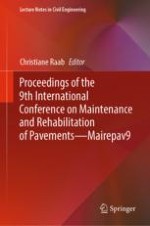2020 | OriginalPaper | Buchkapitel
Three Dimensional Finite Element Model for Active Crack Control in Continuously Reinforced Concrete Pavement
verfasst von : Muhammad Kashif, Pieter De Winne, Ahsan Naseem, Nouman Iqbal, Hans De Backer
Erschienen in: Proceedings of the 9th International Conference on Maintenance and Rehabilitation of Pavements—Mairepav9
Aktivieren Sie unsere intelligente Suche, um passende Fachinhalte oder Patente zu finden.
Wählen Sie Textabschnitte aus um mit Künstlicher Intelligenz passenden Patente zu finden. powered by
Markieren Sie Textabschnitte, um KI-gestützt weitere passende Inhalte zu finden. powered by
